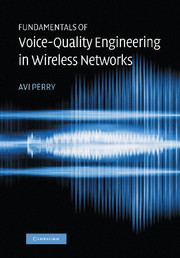Book contents
- Frontmatter
- Contents
- Preface
- List of abbreviations
- Introduction
- Part I Voice-quality foundations
- Part II Applications
- 3 Electrical echo and echo cancelation
- 4 Acoustic echo and its control
- 5 Noisy ambience, mobility, and noise reduction
- 6 Speech-level control
- Part III Wireless architectures
- Part IV A network operator's guide for selecting, appraising, and testing a VQS
- Part V Managing the network
- Part VI Afterthoughts and some fresh ideas
- Part VII Recordings
- Glossary of common voice-quality systems terminology
- Brief summary of echo cancelation and VQS major standards
- Brief summary of key voice-quality assessment standards
- Bibliography
- Index
- Frontmatter
- Contents
- Preface
- List of abbreviations
- Introduction
- Part I Voice-quality foundations
- Part II Applications
- 3 Electrical echo and echo cancelation
- 4 Acoustic echo and its control
- 5 Noisy ambience, mobility, and noise reduction
- 6 Speech-level control
- Part III Wireless architectures
- Part IV A network operator's guide for selecting, appraising, and testing a VQS
- Part V Managing the network
- Part VI Afterthoughts and some fresh ideas
- Part VII Recordings
- Glossary of common voice-quality systems terminology
- Brief summary of echo cancelation and VQS major standards
- Brief summary of key voice-quality assessment standards
- Bibliography
- Index
Summary
Introduction
Chapter 6 is dedicated to the subject of level-control optimization. The presentation is divided into three parts and an introduction. The chapter starts the ball rolling in the introduction by defining standard methodologies for measuring and quantifying signal levels. The first part deals with automatic level control (ALC), how it works, and its placement within the network. The second part describes the adaptive level control, a.k.a. noise compensation (NC), how it works under different codecs, and where it is placed in the network. The third part describes the high-level compensation procedure along the same outline.
Basic signal-level measurements and definitions
One of the most critical speech-quality attributes is the perceived-speech level. When it is too loud, it may either overload or hurt the eardrum. When it is too soft, the listener or even the codec may have difficulties picking up words. There are several different measures and metrics used to measure speech levels. The common thread linking them together to a standardized scale is the unit of measurement defined as decibel and abbreviated as dB.
The human auditory system has a dynamic range of 100,000,000,000,000 (1014) intensity units. This dynamic range is better represented by a logarithmic scale, as a ratio of two intensities, P1 and P2. The expression “log(P1/P2)” is labeled a bel. The resulting number is still too large so, instead, the measure employed is one tenth of a bel or a decibel (dB).
- Type
- Chapter
- Information
- Fundamentals of Voice-Quality Engineering in Wireless Networks , pp. 133 - 144Publisher: Cambridge University PressPrint publication year: 2006



